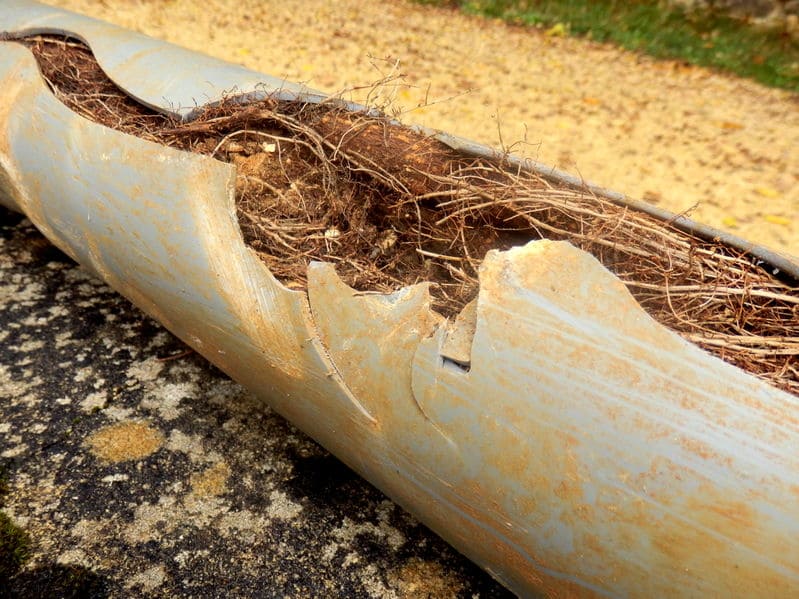How to Tackle Roots in Pipes
CALL (206) 789-4944
Serving the Greater Seattle Area

The Pacific Northwest is a beautiful place in which to live and raise a family. However, two of the things that make it beautiful are the trees and rainfall. Unfortunately, these two aspects combined can wreak havoc on your sewer system with the infiltration of tree roots. When you see all the leaves and greenery above ground just think of all the roots below the soil searching for moisture. Once the roots get into your sewer line, they can crack your pipes and constrict the flow of the sewer. If left untreated, eventually they will back up sewage into your home, and all that that implies…UGH!
It is important to have a professional sewer rooter company come out to evaluate your sewer line. They will be equipped with the proper tools and knowledge to ensure that backup never happens.
In this article, we will focus on how professionals tackle this growing problem here in the Pacific Northwest. We’ll get to the “root” of the issue. Let’s get started!
Understanding the Impact of Tree Root Damage in Sewer Pipes
Here in the Pacific Northwest our grandparents and great grandparents did not have the technology to install state of the art piping, the PVC schedule 40 pipes that we use today. They only had concrete and clay to choose from. In fact, if you locate one old enough, you may even find a wooden sewer!
Over the course of 50 to 100 years of the earth constantly moving, the concrete and clay are now cracking and eroding in the ground. Of course, we can’t really blame the tree roots for their part in this. After all, they are doing what they were designed to do, searching for water and nutrients.
Can Tree Roots Break Water Pipes?
Water pipes, no. But the pipes that make up your sewer lines? Yes, yes they can. Let’s quickly answer the question, “how do roots get into pipes (sewer lines)?“
Sewer lines will naturally have condensation on them, which the tree roots will detect and grow toward. Once there, they can sense all the good stuff inside the pipe and find the little cracks to grow into. The tree roots will, of course, continue to keep growing — the tree root invasion has now hit its stride, unfortunately. The roots in drain pipes will crack and break the sewer line more and could eventually lead to a collapsed line. At the same time, they will also restrict the flow on the inside of the pipe and solids will collect on them. Both ways lead to a big mess inside your home.
While this all sounds scary, it doesn’t have to be! You can avoid potential damage from roots in pipes by contacting a professional sewer rooter company. They’ll come out with a high-tech camera and do a sewer camera inspection to evaluate the condition of your sewer.
The Role of Professional Sewer Rooter Companies
It is common for all pipe-related issues to get looped under the general heading of “plumbing.” Which is fine, because after all that’s what plumbers do, right? The answer is “yes and no.” Think of it like a doctor — when you have an issue you would go to your primary. Then they will hand you over to the specialist for the issue. When it comes to eradicating tree roots in pipes, that is what a professional sewer rooter company like Bob Oates Sewer Rooter is: the rooter service specialists.
It is important to know that when it comes to your sewer line the plumber’s responsibilities and codes end 2 feet outside your home. After 2 feet, the line turns from the building drain to the sewer line. This means it then falls under building codes instead of plumbing codes.
Professional sewer rooter companies will know these codes. They’ll have the certifications, licensing and bonding to go with it. It is also true that regular plumbing companies likely won’t have the correct tools nor the expertise to use these tools in a way that ensures you only deal with this “roots in pipes” problem once.
Assessing Root Intrusion in Sewer Pipes
If you have not had an issue with your sewer line — super! You can avoid the potential of one occurring by calling a professional sewer rooter company like Bob Oates. The first thing our pros will do (providing the line is not backing up) is perform a detailed camera inspection of your sewer line. Most companies will not have a problem with you watching as they do the inspection. In fact, we recommend seeing how everything actually works first hand because it’s kind of cool to witness.
During the inspection they will point out cracks and breaks,and point out other tie-ins from other lines. You will be able to see any root intrusions — the cracks in the line that we mentioned above. Our techs will then be able to line out a detailed plan to keep your sewer line in working order.
Now, if the sewer line is holding water and backing up, the camera will not be able to see anything in the muck. Professionals will need to use a cabling machine to restore flow before doing a camera inspection. It is important to note that a cabling machine is very good at removing the roots from the line. But it is an emergency tool, designed to restore flow, and will not be able to get all the roots out of the line. To completely remove all the roots in drain pipes and sewer lines, our pros use Hydro-Jetting.
How Does Hydro-Jetting Remove Roots in Pipes?
At Bob Oates, we use a large jetting machine with a special “Warthog” attachment. It scours the line clean and cut the roots completely out of the line. However, the roots are still in the cracks and the outside of the pipe and will eventually grow back into the line between six months to a year.
There are also chemical and foaming agents that can be used to treat your sewer line and get rid of roots. But this option also does not permanently fix the issue and eventually the root will get large enough to break the line.
Once the line is clear of roots, a professional sewer and rooter company will then offer a more permanent solution. Options include replacement, restoration and in many cases trenchless sewer repair methods like lining and pipe bursting.
Repairing and Restoring Damaged Sewer Pipes
Luckily, unlike our grandparents and great-grandparents, we have many different options at our disposal for repairing, replacing and restoring a sewer line. And this is something else that will set the professionals apart from an ordinary plumbing company. Sewer rooter pros will be able to implement these techniques without third party involvement. At Bob Oates, we begin by investigating the pipe thoroughly. We will then write out a comprehensive estimate for which of the available options that best suit your needs.
These options include the following techniques as solutions:
Pipe bursting. With pipe bursting, we will need to have two access points in the sewer line, one upstream and one downstream. We then use hydraulics to pull a metal cone that is larger than the existing pipe, through the existing pipe with a new HDPE (High Density Polyethylene) pipe in tow. Essentially, we are pulling a new, better-quality pipe inside the old pipe.
Pipe lining. With pipe lining, we only need one access point. We can sometimes do this from an existing clean out, and therefore avoid having to do any excavating. With pipe lining we take a felt sock and soak it in epoxy or resin, and insert it into the existing pipe. We then install a bladder that we blow up using air until the epoxy cures. We can also use UV lights to quicken the cure time. This way, you won’t be without the use of your sewer overnight. At Bob Oates, we make sewer line repairs a breeze!
Conclusion
For most of us, our home is the biggest purchase we commit to, and we spend lots of time making it exactly the way we like. We also allocate a significant part of our finances to protect it from dangers such as fire, water, electrical mishaps or problems related to plumbing or sewer systems.
In that spirit, tree roots can be maintained with regular cleanings. Once you have invading tree roots, plumbing issues are sure to follow. If they have infiltrated your existing sewer pipe they will usually grow back within a year. Therefore, it’s best not to wait until you have a problem. Take our word for it: they’re likely to grow back sooner than later after cutting them out. This is simply because they have already worked their way into the pipe from the joint or connection.
With today’s modern sewer repair methods — like a glued fitting as compared to the old concrete and or clay pipe used in the past 100 years — tree roots are far less likely to grow through and start wreaking havoc. Being proactive will save you both time and money. And provide the peace of mind knowing you’ve avoided the potential mess of not maintaining an older sewer system.
Final takeaway: out of sight out of mind doesn’t serve you well when roots work 24/7 to obtain the water and nutrients they need to thrive. Call today to schedule regular cleanings, a sewer inspection, or just talk to us about the different options we offer to prevent root infiltration in the future.
At Bob Oates Sewer Rooter, we have the solutions that make it easy to keep your sewer in optimal working order!
FAQs
How Do Tree Roots Get Into Pipes / Water Mains?
Tree roots do not get into potable water pipes — they get into sewer lines, and that’s where the real damage occurs.
Wastewater traveling through a common sewer pipe will, over time, cause condensation to form on the outside of the pipe. Over a period of years and decades, tree roots will find that source of water, grow along the pipe, and work their way into the joints, eventually breaking the joint and growing with the flow of water until they cause a backup due to the root obstructing the inside of the pipe.
Are There Trees Safe to Plant Near Water Lines?
The short answer is yes, because tree roots do not grow into potable water lines. However, a tree planted close to a water main can cause a break due to the weight or a very strong root uplifting the pipe.
Are There Trees That Won’t Damage Pipes?
To answer this question, we need to distinguish between varieties such as conifers and deciduous trees. For example, unlike pine trees (conifers), oaks and maples (deciduous trees) have much deeper root systems, and therefore more problematic if near water and sewer lines.
How Far Do Pine Tree Roots Spread?
By nature, pine tree roots do not grow very deep. In our experience, they do not extend past the drip line of the branches and the ones that do are insignificant. Theirs are more surface roots, not as deep, and why those trees are more susceptible to blowing over.
CALL (206) 789-4944
Serving the Greater Seattle Area





